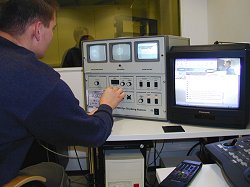 We purchased the ASL tracker in 1996. The ASL tracker is a remote, floor-mounted, eye tracking device. We have used it, e.g., to study how people read menus, or how affective stimuli affects the pupil size.
We purchased the ASL tracker in 1996. The ASL tracker is a remote, floor-mounted, eye tracking device. We have used it, e.g., to study how people read menus, or how affective stimuli affects the pupil size.
The ASL eye tracker was placed under the monitor in the usability lab. The operator could monitor the eye movements and make sure the eye and the pupil are tracked properly. Nowadays all what is inside the big gray box + a camera are integrated in the tiny bar shaped body.
This is the only eye tracker that has exploded in our lab. This happened when one of the fans that keep it cool was malfunctioning and the light bulb used for generating the infrared light overheated. As usual for the robust technology of the past decades, the tracker continued working just fine after the fan and the light bulb were replaced. After the newer trackers such as the Tobii 1750 were acquired, this tracker was used by the ESC group until it was finally archived as a museum piece in 2013.
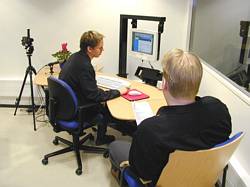 Specifications:
Specifications:
Sampling rate: 60 Hz
Precision: 0.5°
Allowable head motion: +/-15 cm vertical and horizontal
Allowable eye movement: 40° horizontal, 35° vertical
Eyeglasses/contact lens: most are accepted
Eye to camera distance: 50-225 cm

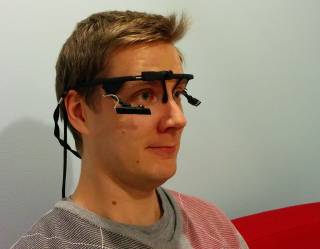 Pupil Labs builds excellent head-mounted trackers with many possible camera configurations. The version we have is from late 2015 with 120Hz eye cameras and a Full-HD scene camera and one USB3 plug for connecting to computers. The software is open source, which allows interfacing and integrating with whatever other software is needed for any given project.
Pupil Labs builds excellent head-mounted trackers with many possible camera configurations. The version we have is from late 2015 with 120Hz eye cameras and a Full-HD scene camera and one USB3 plug for connecting to computers. The software is open source, which allows interfacing and integrating with whatever other software is needed for any given project. With its 1000Hz sample rate and other high performance features the EyeLink 1000 allows us to study details of eye movements at a higher resolution than the other trackers we have. It has been used, for example, to investigate eye movement dynamics in gaze gestures. Requires a headrest for accurate calibration and tracking.
With its 1000Hz sample rate and other high performance features the EyeLink 1000 allows us to study details of eye movements at a higher resolution than the other trackers we have. It has been used, for example, to investigate eye movement dynamics in gaze gestures. Requires a headrest for accurate calibration and tracking.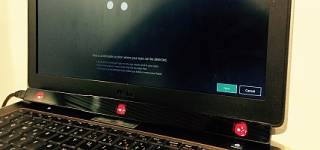 The Tobii EyeX tracker is intended for gaming and other consumer products. It has a different programming interface than the more scientifically oriented Tobii trackers. For many of our interactive prototyping needs, however, it is more than adequate. The low price makes it possible to loan it to students and other collaborators without fear of trouble if an unit is lost or broken. Together with the ET1000 this tracker has by far the best price/performance ratio of all devices that we have seen.
The Tobii EyeX tracker is intended for gaming and other consumer products. It has a different programming interface than the more scientifically oriented Tobii trackers. For many of our interactive prototyping needs, however, it is more than adequate. The low price makes it possible to loan it to students and other collaborators without fear of trouble if an unit is lost or broken. Together with the ET1000 this tracker has by far the best price/performance ratio of all devices that we have seen.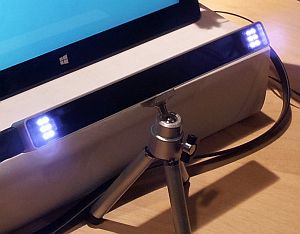 Eye Tribe’s devices were available in early 2014 for developers at a very low price. Several of our researchers ordered them. The application scenarios are similar to Tobii X2-60, but the low price makes it possible to use as many devices as needed. The bright lights you can see in the photo are mostly infrared light that is invisible to the human eye, but is picked up by many digital cameras. All trackers listed on this page use similar illumination to see the eye clearly and to have trackable reflections on the surface of the eye. To the human eye the lighting is seen as a dark red glow that is often barely perceptible.
Eye Tribe’s devices were available in early 2014 for developers at a very low price. Several of our researchers ordered them. The application scenarios are similar to Tobii X2-60, but the low price makes it possible to use as many devices as needed. The bright lights you can see in the photo are mostly infrared light that is invisible to the human eye, but is picked up by many digital cameras. All trackers listed on this page use similar illumination to see the eye clearly and to have trackable reflections on the surface of the eye. To the human eye the lighting is seen as a dark red glow that is often barely perceptible.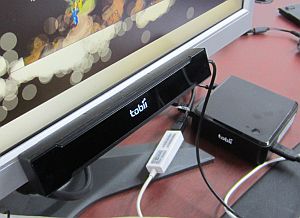 The Tobii X2-60 is a bar-like USB 2.0 device that you can attach to the lower border of a display (or a laptop or pretty much to anything). Our first X2-60 was acquired in 2014. It has a big head box and it is fairly robust regarding environment lighting and head movements (as long as they are not too fast). It is easier to transport for demos and on-site tracking sessions than the T60, for example.
The Tobii X2-60 is a bar-like USB 2.0 device that you can attach to the lower border of a display (or a laptop or pretty much to anything). Our first X2-60 was acquired in 2014. It has a big head box and it is fairly robust regarding environment lighting and head movements (as long as they are not too fast). It is easier to transport for demos and on-site tracking sessions than the T60, for example.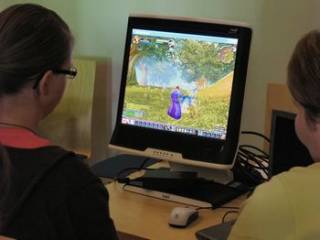 The Tobii T60 is integrated into a 17″ LCD monitor and it provides non-intrusive plug-and-play tracking of the eye movements and gaze direction. We have two of these units. One is usually in the lab, while the other sits on a cart that can be moved to wherever a tracker is needed. We use the T60 for most of the work we do nowadays. This includes a range of gaze related research, such as controlling a computer by gaze alone (playing games by gaze, drawing, text entry etc.), as well as research on gaze behavior (gaze paths, usability studies etc.).
The Tobii T60 is integrated into a 17″ LCD monitor and it provides non-intrusive plug-and-play tracking of the eye movements and gaze direction. We have two of these units. One is usually in the lab, while the other sits on a cart that can be moved to wherever a tracker is needed. We use the T60 for most of the work we do nowadays. This includes a range of gaze related research, such as controlling a computer by gaze alone (playing games by gaze, drawing, text entry etc.), as well as research on gaze behavior (gaze paths, usability studies etc.).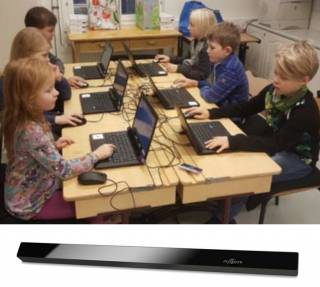 The myGaze device from a spin-off from SMI is like other bar-like USB 2.0 device that you can attach to the lower border of a display (or a laptop or pretty much to anything). From 2016 we possess over a dozen of myGaze devices, part of them with advanced firmware (Assistive) allowing custom calibration routine. The device is fairly robust regarding environment lighting and head movements (as long as they are not too fast) and competes with other cheap bar-like devices from the market leaders.
The myGaze device from a spin-off from SMI is like other bar-like USB 2.0 device that you can attach to the lower border of a display (or a laptop or pretty much to anything). From 2016 we possess over a dozen of myGaze devices, part of them with advanced firmware (Assistive) allowing custom calibration routine. The device is fairly robust regarding environment lighting and head movements (as long as they are not too fast) and competes with other cheap bar-like devices from the market leaders.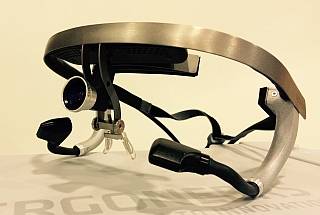 The Dikablis Professional is a binocular head-mounted 60Hz tracker with better mobility than our old EyeLink II. Attached to a windows tablet or a laptop it can stream gaze data over Wifi. With visible tags placed in the environment we can build setups where we can test gaze interaction in everyday environment. Conventional non-interactive eye tracking studies are also possible.
The Dikablis Professional is a binocular head-mounted 60Hz tracker with better mobility than our old EyeLink II. Attached to a windows tablet or a laptop it can stream gaze data over Wifi. With visible tags placed in the environment we can build setups where we can test gaze interaction in everyday environment. Conventional non-interactive eye tracking studies are also possible.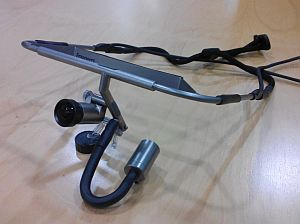 In 2014 while waiting for the shipping of the binocular model we used the older 30 Hz Dikablis Essential for a few prototypes. This tracker fit nicely over eye glasses and worked with our older computing hardware without USB 3 ports.
In 2014 while waiting for the shipping of the binocular model we used the older 30 Hz Dikablis Essential for a few prototypes. This tracker fit nicely over eye glasses and worked with our older computing hardware without USB 3 ports.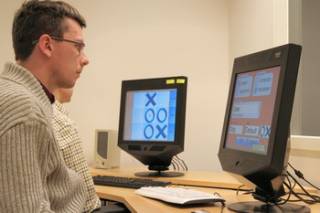 We got the Tobii 1750 eye-tracker in 2004 and updated it to a T60 in 2009. We have used the 1750, e.g., to study the usability of web search engines.
We got the Tobii 1750 eye-tracker in 2004 and updated it to a T60 in 2009. We have used the 1750, e.g., to study the usability of web search engines.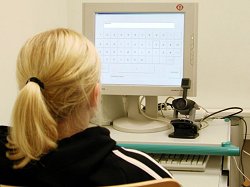 We got the SMI iView X remote tracker in 2002. We have used iView X, e.g., to study eye typing. It was is small enough to be placed beside the monitor. The eye and the gaze path were illustrated in the iView X operator monitor. The system tracked the center of the pupil (black crosshair) and the corneal reflection (white crosshair).
We got the SMI iView X remote tracker in 2002. We have used iView X, e.g., to study eye typing. It was is small enough to be placed beside the monitor. The eye and the gaze path were illustrated in the iView X operator monitor. The system tracked the center of the pupil (black crosshair) and the corneal reflection (white crosshair).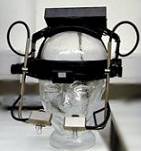 We have had the head-mounted EyeLink since 1999. It has two cameras so it can monitor both eyes at the same time. We have used EyeLink, e.g., to study how people read foreign text, and for usability testing. Eyelink came with a cool glasshead rack for storing the head-worn part when not in use.
We have had the head-mounted EyeLink since 1999. It has two cameras so it can monitor both eyes at the same time. We have used EyeLink, e.g., to study how people read foreign text, and for usability testing. Eyelink came with a cool glasshead rack for storing the head-worn part when not in use. We purchased the ASL tracker in 1996. The ASL tracker is a remote, floor-mounted, eye tracking device. We have used it, e.g., to study how people read menus, or how affective stimuli affects the pupil size.
We purchased the ASL tracker in 1996. The ASL tracker is a remote, floor-mounted, eye tracking device. We have used it, e.g., to study how people read menus, or how affective stimuli affects the pupil size. Specifications:
Specifications: